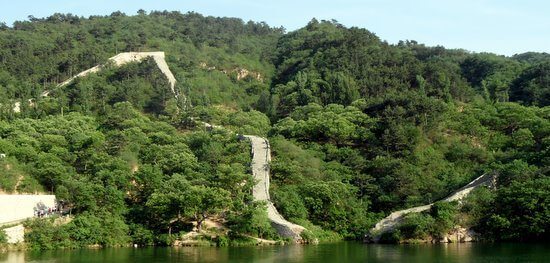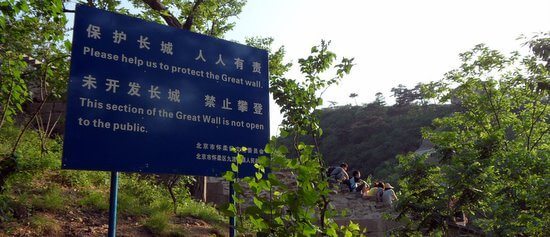A couple of hours north of Beijing the Great Wall can be seen lining the tops the mountain range and occasionally dipping into the valleys. In one of these valleys used to lay the gateway of Xifengkou1, a major strategic pass through the mountains to enter Beijing and one of the few places to hold out against the Japanese invasion in 1933.

After protecting Beijing for 600 years the wall was finally overrun in 1976 by the rising waters of the Panjiakou Reservoir. Now from the tops of the surrounding hills the shimmering waves on the clear water make the underwater blocks look like a silvery dragon winding its way through the lake. Not really, but that’s what you’re told – as with every other tourist spot it supposedly resembles a dragon.
Uniquely, Xifengkou is the only place where the Great Wall dips underwater and it’s been turned into a very pleasant nature park called XiShui Valley Tourist Scenic Spot. The main attraction is the wall and the opportunity to scuba dive down and marvel at how well preserved it remains in the neutral lake.
Lining the lake are numerous fishing platforms with anglers trying to catch the many fish in the reservoir, whilst younger people splash about in pedaloes, trying not to get a suntan.
Outward Bound
The numerous hiking trails and the opportunity to abseil down the dam have led to Xifengkou becoming a popular destination for the Chinese version of Outward Bound courses.

Abseiling at Xifengkou
They then presumably retire to their hotel and over a drink revel in their team working skills giving them victory over nature.
It’s certainly easier than the British version of Outward Bound where people grudgingly go orienteering round Scotland in the rain and at the end of the day are rewarded with skinning and eating a wild rabbit and a night in a leaky tent.
The hiking in the area is actually very good and there are plenty of camping facilities. The paths are well maintained (apart from one particularly high and rickety bridge) and clearly signposted with colour-coded trails.
In the ticket office I also found out about another part of the Great Wall I’m keen to see. At Sandaoguan the wall has been built on the side of a mountain at an incline of 90 degrees, earning the nickname “The Wall Hanging Upside Down”. This section apparently looks like another giant dragon surging forward to the top of the cliffs and then rushing back down into the valley…
1 Xifengkou means happy meeting and is named from a story about a young man forced to leave home and work on the Great Wall. When he didn’t return in the winter his father worriedly came looking for him. When they finally found each other they were so happy they laughed themselves to death and were buried in the pass.
Presumably they died at the same time, otherwise one watched the other die and carried on laughing, which isn’t socially acceptable.

Warning signs are just for decoration here






Pingback: What to Do in Beijing - Travel Tips for Beijing, China